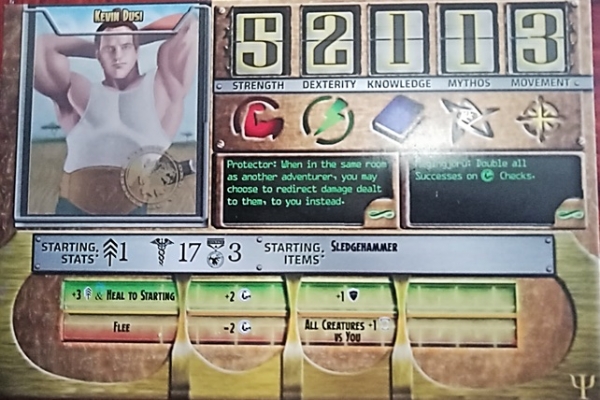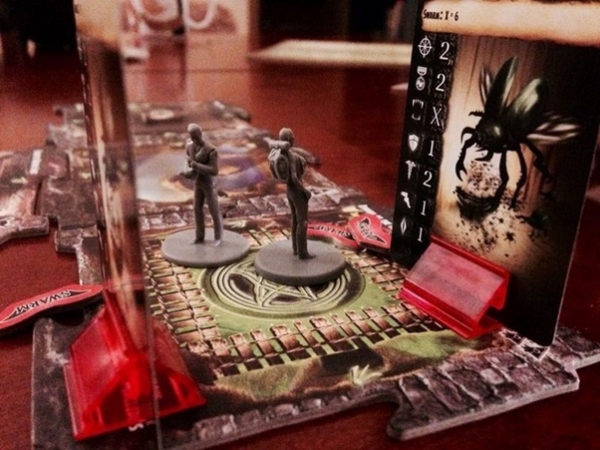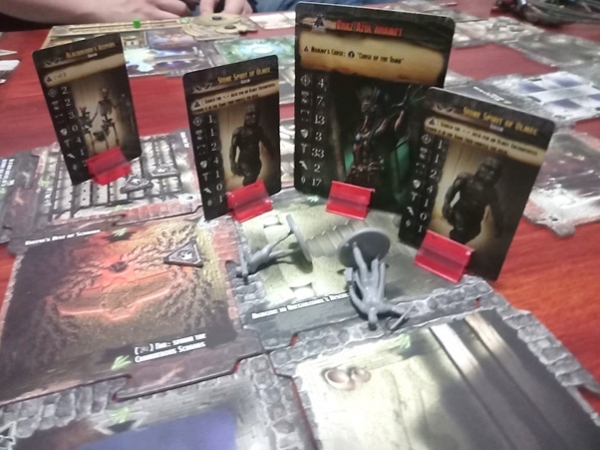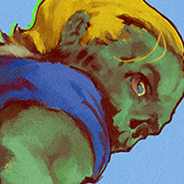As the tabletop design ethos continues to evolve in a cross-continental dance of pollination, systems may morph and intermingle, yet the once binary delineation of Euro vs Amerithrash still often rings true.
Systems vs Theme, Elegance vs Excess, Wood vs Plastic, Mediterranean Trading Routes vs Zombie Hitler.
If one was looking to submit an example of the latter to the Smithsonian for future historians to signpost an era in the history of the hobby, then Secrets of the Lost Tomb by Everything Epic might just be the quintessential selection.
Coffin-boxed and stuffed to the gills with cards, tiles and tokens (oh so many tokens), Secrets of the Lost Tomb hearkens back to a bygone era that recalls both the heady adventure and the fiddly excess of the 90’s- an era where the storytelling potential of the medium was evolving in a bubble far removed from the streamlined settlers that would go on to dominate the European (and eventually world) stage.
Emerging in 2015, bolstered by a succession of expansions and followed by a slightly revised second edition, the game has garnered a fervent cult following amongst a certain subset of gamers who relish the gonzo narrative beats of games like Warhammer Quest, Arkham Horror and even Betrayal at the House on the Hill. So much so that 2021 is set to see the emergence of a long-awaited third edition (that will probably still look like it fell out of a time vortex from 1996).
With those arcane stars aligning, it seemed like the perfect time to ready my whip, tilt my fedora, and dive into that beguiling first edition box to plumb the depths in search of answers, nazi gold and starched jodhpur trousers.
Arizona Smith and the Raiders of the Tomb of the Lost Crusade

The beauty of a big box Amerithrash romp has always been the ability to go hog wild with shit. Balance? Balance is for chumps. Nuance? Hey Poindexter, go back to your weird game about trains. Victory Points? I don’t have time to count them, I’m way too busy hurling fümfty seven proprietary dice at a guy with a flamethrower.
Players enter, stuff happens at them and they strap themselves in for the ride. Randomness creates dissonance, insane story beats twist and turn in erratic loops, the Troll is immune in the Crags, and swinginess conspires to snatch victory from the jaws of defeat and vice versa on the turn of a fickle spinning dime.
To make the most of the possibilities inherent in, and mindset required to enjoy this type of experience, the theming is critical. This is not the time nor place for subtleties, and it is in its embrace of the ludicrous that SOTLT most stridently displays its genius. Inside this pandora’s box lies possibly the most fulsome collision of classic myth and mystery tradition archetypes to ever cohabit cardboard. From Neptune to Nazis, Sphinxes to Samurai, The Holy Grail to the Great Kraken – they’re all here, and what is more, you can don a comically oversized moustache and then shoot them in the face with an elephant gun.
A picture is worth a thousand words so it’s at this point I think you need to cast an eye over the rogues gallery of protagonists on offer. Ripped straight from the finest of pulp serial era derring-do, they’re as informative as any other aspect here when it comes to telegraphing the world that Everything Epic are seeking to evoke, and leave me torn between wanting to either don a wifebeater singlet and oil up my muscles, or wrap myself in a smoking jacket whilst I surreptitiously fondle a looted antiquity.

The artwork. Oh my god the artwork. It’s terrible. I LOVE IT. Is that Boy George in the middle next to Tim Brooke Taylor? But wait, check out this dude:

And he’s armed with a Sledgehammer. Taunted by the malevolent spirit of an ancient Egyptian God as you seek to decipher a Rosicrucian riddle penned in cuneiform whilst dodging poison darts? SLEDGEHAMMER.
It’s that kind of game.
No Place for the Penitent Man
After you’ve finished arguing about who gets to be Kevin Dusi, you’ll select one of a number of scenarios from the core set or one of the many expansions, each complete with their own objectives, victory conditions and rules additions/exceptions. As an example – on our second visit to the tomb we were tasked with decoding a secret message in the correspondence of the American founding fathers that outlined the roles of the Demon Wendiga and Great Kraken in the American War of Independence, a truth excised from our historical texts by an order of Freemasons. En-route we were beset by ghost pirates, swarms of carnivorous scarab beetles, the sirens of Greek mythology, and Olmec golems. Oh, and we also located the fabled fountain of youth, crossed the river Styx and looted the banquet hall of Ghengis Khan. On our third expedition I’m pretty sure we were meant to be milking possessed creatures so we could fill an enchanted urn with demon cum.
It’s that kind of game.

Each character has a set of stats encompassing their strength, dexterity, knowledge, mythos, moustache and whatnot. These basically indicate how many dice they’ll get to roll both during combat and relevant encounter/ adventure checks. Success on fives and sixes, yadda yadda. Throw in some buffs from equipment, companions, relics and upgrades and you can be throwing ten or more at a time. Cool!
It’s also fiddly as shit-especially as the amount of cards and tokens you’ll be required to stack and cross-reference for every encounter multiplies with a mounting insistence throughout the game.
And you’ll be doing a lot of encounter checks.
Each turn as you and your cadre of explorers venture into the tomb you’ll be revealing and placing a set of modular tiles that may feature location specific events as well as triggering adventure/misadventure cards that induce a narrative whiplash so ludicrous that you simply have to go with it. Examining an ancient pagan fertility shrine? WEREWOLVES! Stumbled upon the biblical garden of Eden? RELEASE THE DOGS WITH BEES IN THEIR MOUTHS AND WHEN THEY BARK THEY SHOOT BEES AT YOU. Also you just made friends with a talking sword, and one of your companions has thrown a live stick of dynamite into the room.

If this sounds awesome that’s because it absolutely is. By making the central premise of the titular tomb an anomaly of time and space that houses the greatest treasures and mysteries of our collective cultures, SOTLT makes more focussed jaunts seem utterly pedestrian in their failure to harness the madness that powers the cogwheel heart of Amerithrash. Everything is in here, and it can and will happen to your face. The tomb gives no fucks whatsoever. Not for evolutions in design trends, not for prevailing aesthetic sensibilities, not for streamlined systems, and certainly not for your hopes of claiming the fabled Rod of Xythaga before you’re devoured by a swarm of pythons.

Atomic Fridge
It’s fiddly to a fault, the components are cheap, combat can be a chore, it spawls across the table, at times it’s borderline broken and due to the emergent nature of play it can definitely run looong. But somehow- perhaps the Tomb’s greatest secret is that despite all that- it’s awesome. A guilty pleasure, an exasperating rollercoaster, a hit with everyone who’s sat down to blunderbuss and safari suit their way through the madness with me.
If the goal of thematically-tilted games is that they act as a story-generation engine then this thing runs on perpetual motion.
Now go wrestle some undead alligators before the comet of doom descends. Zeus is counting on you or some shit.

 Games
Games How to resolve AdBlock issue?
How to resolve AdBlock issue? 






















